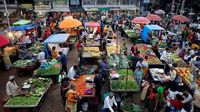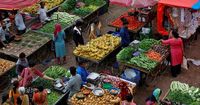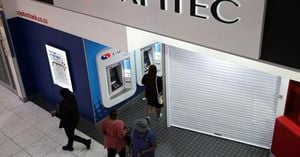India's retail inflation has experienced a significant decline, easing to 3.34% in March 2025, marking the slowest pace in over five years. This figure is notably lower than economists' expectations of 3.60% and represents a decrease from February's inflation rate of 3.61%. According to government data released on April 15, 2025, this is the lowest inflation rate since August 2019.
Analysts attribute this easing primarily to a drop in food prices, particularly vegetables, which have seen substantial deflation. Aditi Nayar, Chief Economist at ICRA, highlighted that the unexpectedly sharp sequential fall in the headline Consumer Price Index (CPI) inflation was predominantly led by food items such as meat, eggs, and vegetables. She noted, "Further monetary easing is clearly on the table, to the tune of 50 bps over the next three policies. A June 2025 rate cut seems highly likely." This sentiment is echoed by other economists who see the current inflation trends as providing the Reserve Bank of India (RBI) with the space to continue cutting rates to stimulate growth.
In March, the food inflation rate dropped to 1.57%, down from 3.38% in February, driven primarily by a notable decline in vegetable prices, which fell sharply by 15.88%. Other items contributing to the decline included pulses and meat. However, inflation in manufactured products rose to 3.07%, and fuel and power inflation turned positive at 0.20%.
According to Gaura Sen Gupta, an economist at IDFC First Bank, the moderation in CPI inflation is largely due to food inflation, with expectations of average inflation settling at around 3.5% for FY26, contingent on an evenly distributed monsoon. She stated, "Based on domestic factors alone, we see space for another two rate cuts minimum in the remainder of 2025." This optimistic outlook is further supported by the anticipated improvements in agricultural production, particularly with the Rabi and Kharif crops.
Moreover, the RBI has already cut the repo rate by 50 basis points in its last two Monetary Policy Committee (MPC) meetings, with the latest cut occurring in April. The RBI's current stance appears to prioritize growth, as the softer-than-expected CPI inflation provides comfort to maintain an accommodative monetary policy. Upasna Bhardwaj, Chief Economist at Kotak Mahindra Bank, indicated that the terminal repo rate could settle around 5-5.25% as inflation pressures remain benign.
Despite the positive trends in inflation, there are still concerns regarding potential risks. Joe Maher, an assistant economist at Capital Economics, warned that while supportive weather conditions may help keep food inflation in check, underlying price pressures could remain subdued as the economy continues to recover from recent challenges.
On the wholesale side, the Wholesale Price Index (WPI) inflation also eased to a four-month low of 2.05% in March, down from 2.38% in February. This decline in WPI inflation was largely attributed to a decrease in food prices, with WPI-food inflation slowing to 4.66% from 5.94% in the previous month. Aditi Nayar noted that ongoing deflation in non-food items contributed to lowering the overall headline figure.
As the government and economic analysts monitor these inflation trends, the RBI is expected to remain vigilant regarding global volatility and erratic weather patterns that could impact agricultural output and food prices. The RBI has projected CPI inflation for FY 2025-26 at 4%, assuming a normal monsoon, with quarterly projections indicating a gradual increase throughout the year.
The government has recently increased excise duties on petrol and diesel by Rs 2 per litre, which has raised concerns among consumers. The excise duty on petrol is now Rs 13 per litre, while diesel stands at Rs 10 per litre. Additionally, the price of domestic cooking gas (LPG) has risen by Rs 50 per cylinder, prompting criticism from opposition parties.
Congress party officials have called for a special session of Parliament to address inflation concerns and have demanded immediate relief measures for consumers. Alka Lamba, head of the Congress women's wing, criticized the government for what she described as neglecting the inflation crisis while prioritizing revenue generation for the state.
The opposition has pointed out the stark contrast in fuel prices between the current administration and previous governments. In 2014, petrol was priced at Rs 72 per litre, while today it ranges between Rs 98 and Rs 100 per litre. Diesel prices have similarly risen from Rs 55 to Rs 88 per litre under the current government. Lamba emphasized the need for a comprehensive audit of these price hikes, stating, "Our demand is that a CAG audit should be done in this matter. If this does not happen, it will be clear that BJP is involved in this whole matter."
As the economic landscape evolves, experts remain cautiously optimistic about the trajectory of inflation in India. While the recent data suggests a cooling trend, the interplay of domestic agricultural conditions, global market influences, and government policies will be crucial in shaping the economic outlook for the remainder of 2025 and beyond.
In summary, the latest inflation figures reflect a significant easing in price pressures, particularly in food commodities. With the RBI likely to continue its accommodative stance, further rate cuts could be on the horizon, providing a potential boost to economic activity as the country navigates the complexities of domestic and global economic challenges.





